
Vibratory Conveyor: The Complete Guide for Industry Professionals
- posted by: Indpro Engineers
- No Comments
Just imagine the following situation: you are managing the operations in a food processing plant. Your manufacturing process is smooth, but every so often, there is a block. The bins become clogged with powders. The flow of materials is uneven. It requires manual involvement. It take everything slowly.
And that was the issue being experienced by a food manufacturer in Madhya Pradesh. Poor flow by hoppers and silos kept on stalling their operations several times a day. The solution? The combination of the Vibratory Conveyor system with bin fluidizers, bin vibrators, and the change was impressive.
So, let us go into detail about what a vibratory conveyor is and what actual industrial issue it can resolve.
What is a Vibratory Conveyor?
A vibratory conveyor is a mechanical conveyor system that transports bulk material by means of vibration as opposed to the use of belts, chains, or rollers. These conveyors are best suited for the transfer of fine powders, granules, pellets, and even delicate goods such as food products.
Vibratory conveyors, when compared with traditional systems, provide a vibration that moves materials induced by gentle and precise vibration along the surface of a tray, tube, or trough. These systems especially apply in the industrial settings such as
- Sustenance and drink
- Pharmaceuticals
- Chemicals
- Mining
- Fertilizers
The materials discharge equipment is usually found in combination with vibratory systems such as the use of bin fluidizers, bin vibrators, and vibratory feeders to make the flow of material smooth.
Vibratory Conveyor: How Does It Operate?
- The working principle is easy yet effective.
- Vibrations are produced by an electric motor or an electromagnetic drive.
- The conveyor tray or tube receives these vibrations.
- The content on the tray flips or slides forward in precise movement.
Several systems have a vibratory feeder at the head to keep material pouring into the conveyor and a bin fluidizer or bin vibrator under storage bins to prevent material in the bins from bridging and starving the system at the head end. These elements facilitate the freeing of clumps of material and also avoid bridging, promoting a regular material feeding.
For delicate materials or dusty environments, a vibratory tube feeder can be used. It’s an enclosed version of the standard tray conveyor that prevents contamination and material loss.
Types of Vibratory Conveyors
There are various types of vibratory conveyors designed to suit different applications. Here are the most common:
- Natural Frequency Vibratory Conveyor
- Forced Frequency Conveyor
- Vibratory Tube Feeder
- Inclined vibratory conveyor
- Vibratory Feeder
- Bin Vibrator
- Bin Fluidizer
Together, these components create a complete flow solution from storage to processing.
Cost of Vibratory Conveyors
The price of a vibratory conveyor depends upon:
- Size and capacity
- Type of material (e.g., stainless steel and mild steel)
- Drive relay (electromagnetic; mechanical)
Other parts, such as vibratory feeders, bin fluidizers, and bin vibrators,
Price Range:
- Small Units: ₹50,000 – ₹1.5 Lakhs
- Medium Industrial Systems: ₹1.5 Lakhs – ₹5 Lakhs
- Custom Solutions (including vibratory tube feeder or vibratory screener): ₹5 lakhs and above
The initial investment may be large; nevertheless, the ROI is favorable. The system can be paid off in months with reduced downtimes, easy flow, and increased production.
The buying guide to vibratory conveyors.
A checklist to consider to buy the correct vibratory conveyor will be as follows:
- Know Your Stuff
Is your matter free-flowing or sticky? Fine or grain? The answer will decide whether you would require special devices like a bin fluidizer or vibratory feeder.
- Throughput Requirements
How much material do you require to be moved per hour? Select a system sufficient to at least this figure.
- Space Constraints
Does your plant have restricted space? In this case, opt for compact designs such as vibratory tube feeders.
- Automation degree
Labor is easily halved by using automated systems, where the sensors and vibratory screeners make the whole process a lot more accurate.
- Maintenance and Support
Ask a vendor which provides a good after-sales service, particularly on important components such as bin vibrators and drive units.
Indian best manufacturing company.
There are some of the main manufacturers and producers of vibratory solutions in India. It is one of the finest in the industry.
Indpro Engineers Technologies
The reason why Indpro engineers are special:
- Design and engineering service
- Complete spectrum: vibratory conveying, vibratory feeders, bin fluidizing, vibratory tube feeding, and vibratory screeners
- Global standards made in India
- Speedy delivery and good service
Before finalizing a supplier, always check for:
- Industry experience
- Customization capability
- Quality certifications
- Customer testimonials
Conclusion
A vibratory conveyor is not just a machine—it’s the backbone of efficient material handling in many industries. When combined with the right accessories like a bin fluidizer, bin vibrator, or vibratory feeder, it helps eliminate downtime and increase productivity.
Whether you’re processing food, pharma, or chemicals, investing in the right system—especially from a trusted Indian manufacturer—can lead to safer, faster, and more reliable operations.

